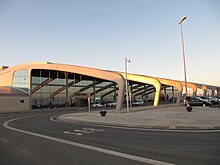
Castile and Leon is a autonomous communitySpanish located in the north sub plateau. Due to its extension (it is one of the widest regions of Europe), this community presents a great geographical and cultural diversity: the community contains from remote places in the cereal-colored plains to high peaks such as the "Picos de Europa", passing through large cities such as Valladolid that sits in an area with a lot of water in relation to the rest (in Valladolid we find the Douro River, the Esgueva and the Pisuerga, Besides of Castile Canal and the Duero Canal). It limits the north with the Principality of Asturias, Cantabria and the Basque Country, east with The Rioja Y Aragon, to the south with the Madrid's community, Castilla la Mancha Y Estremadura, and to the west with Galicia Y Portugal.
Regions
The Autonomous Community of Castilla y León it combines in its origin as an administrative entity Old Castile (provinces of Ávila, Burgos, Palencia, Segovia, Soria and Valladolid) and the old Kingdom of Leon (provinces of Salamanca, Zamora and León).
It is therefore made up of nine provinces:
Cities
Province capitals









More cities and municipalities
- Astorga, Lion
- Bejar, Salamanca.
- Ponferrada, El Bierzo.
- Bembibre, El Bierzo.
- Benavente, Zamora.
- Candelada, Ávila.
- Rodrigo City, Salamanca.
- Cuellar, Segovia.
- The Burgo de Osma, Soria.
- La Alberca, Salamanca.
- Lerma, Burgos.
- Miranda de Ebro, Burgos.
- Puebla de Sanabria, Zamora
- San Felices de los Gallegos, Salamanca.
- bull, Zamora
- Penafiel, Valladolid.
Other destinations
- Arribes del Duero Natural Park
- Sierra of France, Natural Park of the Batuecas - Sierra de Francia.
- The Black Lagoon, Soria Natural Park.
- Sanabria Lake Natural Park.
Understand
Castilla y León is an autonomous community of Spain, the largest in the country; in fact, it is the largest sub-national political division in the European Union. It is formed by the union of two ancient kingdoms: Castilla la Vieja (Ávila, Burgos, Segovia and Soria) and the Kingdom of León (León, Zamora, Salamanca, Palencia and Valladolid), which separated and reunited several times in the Middle Ages. . .
- Tourist information
Weather
Castilla y León has long and cold winters, with average temperatures between 3 and 6 ° C in January, and short and hot summers (19 to 22 ° C on average), but with the three or four months of summer aridity characteristic of the Mediterranean climate . . Precipitation, averaging 450 to 500 mm per year, is scarce and is accentuated in the lowlands.
To get
By plane

- Valladolid airport[1] (IATA code: VLL, OACI code: LEVD), 10 km from Valladolid. Several bus lines link the airport with the center of Valladolid and the cities of Lion Y Salamanca.
- Destinations: Barcelona, Brussels, London, Tenerife, Saragossa.
- Leon airport[2] (IATA code: LEN, ICAO code: LELN), 6 kilometers from Lion
- Destinations: Alicante, Barcelona, Malaga, Palma de Mallorca, Valencia.
- Salamanca airport[3] (IATA code: SLM, ICAO code: LESA), 15 kilometers from Salamanca. A bus line connects the airport with the city.
- Destinations: Barcelona.
- Burgos airport[4] (IATA code: RGS, ICAO code: LEBG), 4 kilometers from Burgos. Burgos Urban Bus Line 24 connects the airport with the city center
Travel
The best way to travel long distances within the region is by train. High-speed trains run several times a day on the Madrid-Segovia-Valladolid-León line, otherwise Medium Distances (MD; corresponds approximately to an Interregio) and Regional Express (RE) are offered.
Castilla y León has an extensive railway network, which includes the main lines from Madrid to Cantabria and Galicia. The line from Paris to Lisbon crosses the region and reaches the Portuguese border at Fuentes de Oñoro in Salamanca. Astorga, Burgos, León, Miranda de Ebro, Palencia, Ponferrada, Medina del Campo and Valladolid are important railway crossings.
The region is also crossed by two important ancient routes:
- Camino de Santiago, hiking route and highway, from east to west.
- The Roman Vía de la Plata ("Vía de la Plata"), a main thoroughfare that runs through the west of the region.
Talk
- In this Autonomous Community the official language is Spanish or Spanish and they protect the Galician, spoken in the areas bordering Galicia, and the Leonese or Astur-Leonese, spoken in the areas of the province of León bordering Asturias.
To buy
To eat
Castilla y León is an area very rich in gastronomy. In addition to the well-known roasts of suckling lamb and suckling pig or tostón, there is a great variety.
- Meats are probably the main dish on every Castilian table. In Avila the veal stands out, in Salamanca the Iberian pork products, and in León the cecina, without forgetting the blood sausage from Burgos or the botillo from El Bierzo.
- Among the pots we highlight the Castilian stew, composed of 3 dishes: soup, legume and meat. The cocido maragato, which is eaten upside down, ending with the soup. The Salamanca chanfaina and Burgos rotten pot are other examples.
- Legumes such as chickpeas from Fuentesaúco (Zamora), lentils from La Armuña, beans from El Barco and La Granja and red beans from Ibeas are renowned.
- Cheeses, sweets and wines complete the wide gastronomic panorama.
Drink and go out
Sleep
Learn
Respect
Health
Keep in touch
Surroundings
external links
 Wikipedia has an article on Castile and Leon.w: Castile and León
Wikipedia has an article on Castile and Leon.w: Castile and León Wikimedia Commons houses multimedia content about Castile and LeonCommons.
Wikimedia Commons houses multimedia content about Castile and LeonCommons.- You will find a good guide to cities, towns, itineraries and other very useful information on the website of The Junta de Castilla y León.
